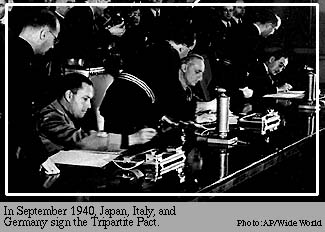WWII
Home / Pearl
Harbor Home
 |
| Japan responded to America's actions by joining Nazi
Germany and Fascist Italy in the Tripartite (three-part)
Pact.
In this agreement, the two European dictators approved
Japan's goal for an Asian empire. The three countries
pledged to support one another if any one of them was
attacked by the U.S.
President Roosevelt answered this challenge by seizing
Japanese money and property in the U.S. and placing
an embargo
on exports of oil, steel, and iron to Japan.
Great Britain and the Netherlands, who had colonies
in East Asia, also cut off exports of oil to Japan.
|
 |
Japan felt it had to act. Without oil and metal, Japan
couldn't continue the war in China, let alone win the
Pacific empire its military rulers craved. The nation
would have to go to war to seize these resources. But
war against whom? The army wanted to attack the Soviet
Union, which was fighting a war against Nazi Germany.
The navy favored seizing the Dutch East Indies (now
Indonesia), British Malaysia, and the American Philippines.
For the navy's plan to succeed, however, it would
first have to destroy the U.S. Navy's Pacific Fleet,
which was based at Pearl Harbor, Hawaii.
Pearl Harbor Activity Station
In 1940, did Americans have any idea that Japan was
considering attacking their country? Did they think
the naval base at Pearl Harbor was in any danger?
Check the eyewitness interview to see what they thought. Or, ask a friend or relative who lived through Pearl Harbor about what Americans thought at the time. Did they expect Japan to attack?
Embargo - an official order forbidding something from
happening, especially trade.
 Top of Page Top of Page
Pearl Harbor Story |
Time Line |
Relive Pearl Harbor |
Meet the Eyewitnesses
Interview with the Eyewitnesses |
Teacher's Guide
|

